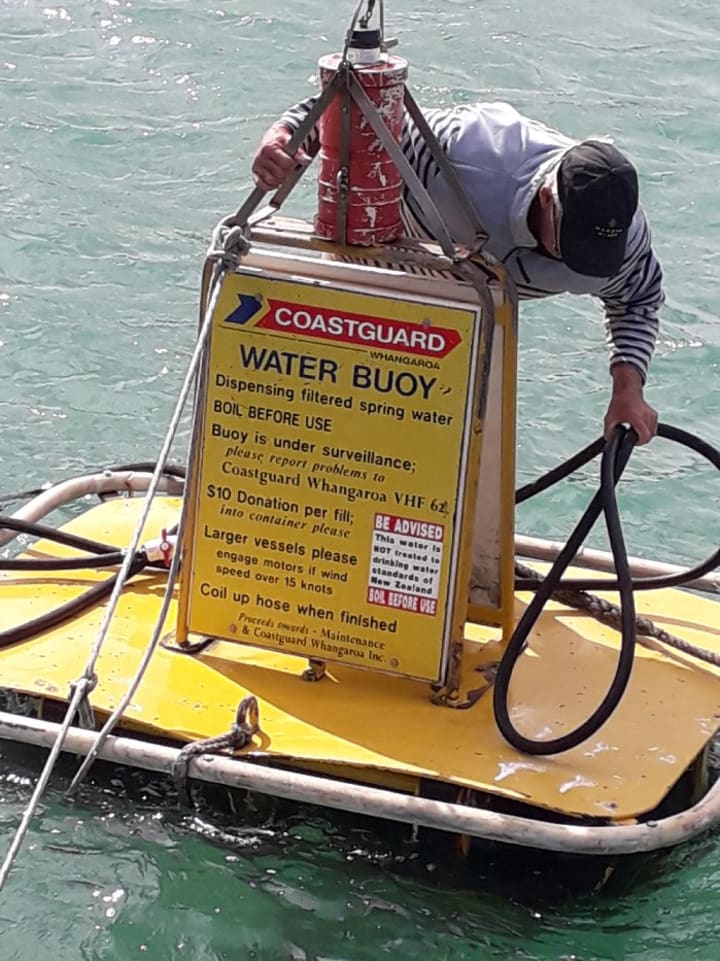The Waterbuoy
Water, water everywhere but not a drop to drink - how much of a challenge is it to obtain fresh water when living on a boat?

Water, water everywhere but not a drop to drink.
This well-known phrase was created by Samuel Taylor Coleridge (1772–1834) in The Rime of the Ancient Mariner (1798). In fact his actual words were:
Water, water everywhere, nor any drop to drink
Now I’m close to being an ancient mariner, but I haven’t — and don’t ever intend to — kill an Albatross. I’ve seen quite a few of them here in the South Pacific and they are magnificent creatures with huge wingspans. They don’t have a freshwater problem as their bodies process the salt water that they ingest with their food.
It’s a bit different for me. My water has to be fresh(-ish). And the First Mate is even fussier. Human kidneys do not like salty water and neither does the heart.
How far will my boat go?
Yes, it sounds like a landlubber’s question, the sort I’m sometimes asked.
The answer is: Pretty much anywhere — if it has enough fresh water for its crew. In the tropics we’d need at least 4 litres a day per person and that’s just to drink.
Sure, I can wash in salt water and frequently get doused by it when we’re in ocean-going mode. But it’s not comfortable.
In ocean going mode, fully tanked up, we’d have maybe 700 litres aboard.
Also, when we’re in ocean-going mode we may want to change our underwear occasionally. And wash it. Clothes washed in salt water are just not comfortable in the underworld. Itchy.
And we like to treat ourselves to the occasional fresh water shower if there’s an ‘r’ in the month.
The longest stretch for me was 39 days at sea non-stop (and slow) from Salvador in Brazil to Santa Maria in the Azores. There were two of us aboard and we still had plenty of water when we made landfall.
Watermakers
People don’t realise that the Sun is our watermaker, driving the atmosphere and generating rain. The bulk of the world’s drinking water comes ultimately from rain. The rest comes from mechanical/electrical water purification plants using condensers or revere osmosis membranes.
Many boats have watermakers these days. You just have to carry fuel to run an engine to generate power to run a watermaker. They are complex beasts with expensive filters.
As an engineer once said to me:
A watermaker is a very inefficient way of converting diesel fuel into water.
But technology is improving and modern watermakers can be run using solar power, even on boats. We do have solar panels, but no watermaker.
There’s enough expensive complexity on modern boats and I don’t need any more on mine. I have enough things to fix already, with a list as long as your hosepipe. I don't need to spend (can't spend) several thousand dollars to add to my worklist.

Pickling the watermaker is a regular maintenance task they say. I’d rather get pickled myself. And backflushing? That’s another regular demand of watermakers, it seems. It sounds like colonic irrigation (and yes, that is basically the principle, I checked). Who needs all this crap backflushing?
Just think: You’re half way across the Atlantic and the watermaker croaks. Spares aboard? Maybe. So, worst case you’re half way across and you have to have your tanks half full to complete the passage alive anyway, and maybe catch rain. That’s my take. Other views are available.
But better technology is on the way, they say. Graphene, superhygroscopic gels and so on. Just like nuclear fusion.
Topping up our tanks
Most places we visit have drinking water of reasonable quality available, even on remote islands, if they are inhabited. Sometimes it’s bottled. Or sometimes there’s a tap, or a spring, even a well.
I remember someone once telling me that it’s safe to take water from a clear mountain stream. If there’s a dead sheep in it then you need to go just 50 meters downstream and it will be safe due to the oxygenation of the water as it tumbles over the rocks. Duh? I never understood that. Why not just take the water upstream from the sheep?
Anyway we don’t do mountain streams in our boat.
We’ll fill jerry cans and tank up, lugging them in the dinghy. It’s heavy work.
If there’s any doubt about the quality of the water I’ll add a thimbleful of bleach to every 20 litre can. It’ll pass through a silver-impregnated filter before we use it anyway.
[memo to self: must change that filter soon. Have I got a spare?] Yes. done. Now I need a spare...
Rain: Yes, we catch it in canvas awnings and buckets as it pours off the sails by the gallon in a downpour. That supplements our needs and tops up our tanks. But if the weather is rough then there can be a lot of salt spray flying which contaminates the rain catcher.
And it’s pleasant to shower in a downpour. No, I’m not posting videos here, but it can be fun!
Dockside fillup: the easiest definitely. Water is not always ‘potable’ but we manage with it, unless the tea tastes unpleasant. That’s less of a problem with coffee though. ‘Potable’ means different things in different places. Often ‘not potable’ is just a get-out from being sued because it has to be regularly tested and that’s expensive. It depends on a country’s laws. For example in this respect Australia's laws are the opposite of those in New Zealand.
But you have to have a handy dock for this.
The unusual: We don’t do high latitude sailing so melting snow or ice isn’t on our daily to-do list, although we did get dumped on once in Cherbourg. There’s a song called Les Parapluies de Cherbourg because it always rains there. Not that day. That snowy day I need more than an umbrella in the blizzard:

There was water on the dock next to the boat, so why melt snow? But even in these situations the supply pipes can freeze. That stay was OK, the snow only lasted a few days.
And that’s where I come to the title of this article:
The Waterbuoy

These are few and far between but recently we used one in NewZealand. Our main tanks were almost empty (though we had reserves in cans). We’d been anchored nearby for a few days waiting for the very gusty wind to ease so we could hook up to the waterbuoy for filtered spring water.
The wind eased a tad but even so it was a tricky process and I needed to use the RIB (dinghy) and extend the hose.

There was a $10 honesty box in support of the local coastguard who run the setup. The buoy itself was not very stable to stand on and when I returned the hose pipe I wore a life jacket.
So there you have it - that’s the watered down version.
And if the water is still tasting I add a tot of whisky. That usually helps, but not before breakfast. Just before lunch, maybe — I think that Denis Thatcher used to call it a ‘brightener’. Sounds right.
But no, I really don’t take alcohol before lunch, although we do have lunch very early on our boat.
Just kidding.
Living and writing on a boat certainly has plenty of variety, but I know it’s not to everyone’s taste. Could it be something in the water I wonder?
This story was first published in Medium on 6 March 2022
About the Creator
James Marinero
I live on a boat and write as I sail slowly around the world. Follow me for a varied story diet: true stories, humor, tech, AI, travel, geopolitics and more. I also write techno thrillers, with six to my name. More of my stories on Medium






Comments
There are no comments for this story
Be the first to respond and start the conversation.